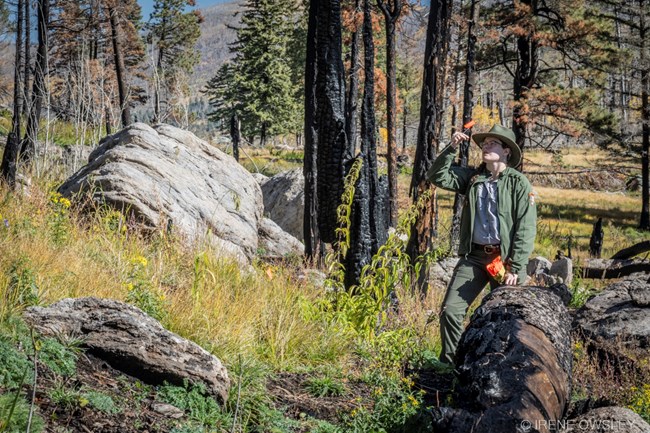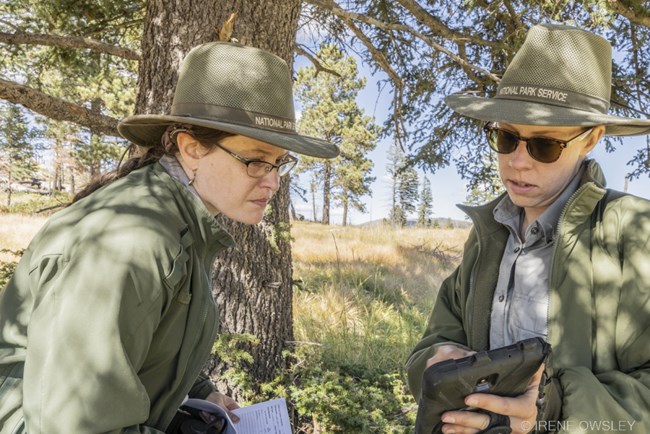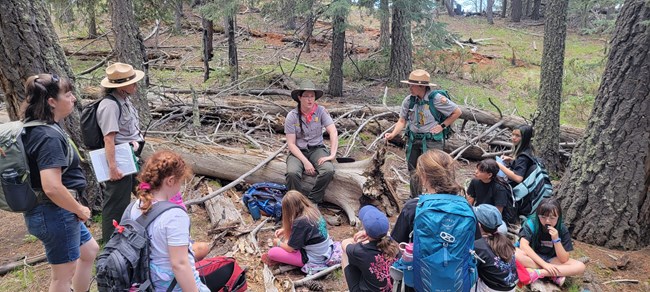Last updated: December 5, 2024
Article
Deaf History Month Spotlight: Mallory Hawk

NPS/Irene Owsley
"Many people feel nervous or awkward to come forward and ask questions directly to the members of the disabled population. I tell everyone - don't be afraid to ask questions, to learn how to best communicate with me and learn about my disability."
People with disabilities—permanent or temporary, visible or invisible, are the largest minority in the United States. But their stories and histories often remain untold, or their disabilities are hidden. Disability history does not follow a single, chronological thread. Instead, it is a flow of simultaneous triumphs and struggles.
April is Deaf History Month, and to celebrate the successes of our colleagues who are deaf or hard of hearing, we are sharing their stories and experiences this month. Meet Mallory Hawk, archeologist at Valles Caldera National Preserve.
How long have you worked for the National Park Service? Which other parks and public lands have you worked in?
I started my archaeology career doing research archaeology in Belize and Guatemala. I studied Mayan and Olmec archaeology and excavated Mayan ruins from 2013 to 2015. During my first year working for private cultural resource management companies, I learned that it was not an ideal fit for me, so I went the federal route. I worked for the United States Forest Service from 2016 to 2018 in the Black Hills National Forest of Wyoming and South Dakota, the Arapahoe-Roosevelt National Forest and Pawnee Grasslands in Fort Collins, Colorado, and the Green Mountain National Forest of Vermont. I became an employee of the National Park Service in 2019, working at Mount Rainier National Park for two years, then North Cascades National Park Complex, and finally moving to New Mexico for my first permanent appointment at Valles Caldera National Preserve in July 2021.
How did you develop an interest in archeology?
When I was 8 years old, I made the radical decision to pursue my dream career as a Southwest archaeologist. I grew up in the Pacific Northwest in the state of Oregon. Growing up, my parents collected kachina dolls and Southwest ceramic pottery (bowls and vases) from their trips in Arizona and New Mexico. They decorated some of their rooms in New Mexico/Arizona Puebloan style decor. I also grew up watching the Indiana Jones films, which influenced my decision to pursue archaeology. I loved the fantasy of going on new adventures, traveling the world, meeting new people, and learning their cultures.
I enjoyed school field trips to science museums that featured archaeological exhibitions. My grandmother lived in Denver, and during my visits, she would often take me to the Denver Museum of Natural History and Science for the archaeological exhibitions of many cultures (Egyptian, Viking, Mesopotamian, Mayan, and others). Later on, when I was in my mid-20s, I worked for the same museum to assist with the collections, laboratorial work, and anatomy of their mammalian and avian collections, with emphasis on zooarchaeology.

NPS/Irene Owsley
Tell me about your average day as an archeologist at Valles Caldera.
There are two seasons for many professional archaeologists. There is the off-season (winter) and field season (summer).
The off-season at Valles Caldera is usually from December to April. During my average off-season day, I'm working in the office and teleworking, writing technical reports of cultural findings, reviewing academic and technical reports, organizing databases, and doing laboratory and collections work. During the field season, which is usually May to November at Valles Caldera, I do fieldwork. I document and record cultural sites and resources at Valles Caldera by drawing sketches, taking photographs, using GPS to map archaeological sites, and writing in my field journal. Sometimes, I assist in large-scale archaeological block excavations. Sometimes, I give presentations about archaeology at conferences, public events, or on live webinars. Sometimes, I assist with academic publications and scientific research.
When new park projects are planned (like installing signs, improving roads and trails, or repairing structures), I investigate the proposed site's area of potential effects (APE) and record any new or known cultural/archaeological sites within the project boundary. Our team also works with the State Historic Preservation Office and 38 tribal offices for Section 106 consultation about the project and a comprehensive review of known cultural resources in the project area. Based on the consultations and field results, we make recommendations that will help protect cultural resources during the project.
What is one of your greatest strengths and/or accomplishments?
I made many sacrifices to pursue my dream of becoming an accredited and professional archaeologist. People tell me how I overcame the impossible odds to become a professional archaeologist as a deaf/hard of hearing woman. I'm a very determined and stubborn person who will knock on many doors, learn as much as possible to be the best archaeologist, and give my all to my profession.
One of my greatest accomplishments was being an invited guest lecturer for the National Technical Institute for the Deaf (NTID), sponsored by the Rochester Institute of Technology, for a national live webinar for deaf children from ages to 9 to 14 across many schools in the country. This webinar was about my archaeology career, how I became an archaeologist, and offering my experiences as a deaf/hard of hearing person. This gave me the platform to share my experiences and inspire deaf children to pursue their dreams - no matter how impossible it may seem.
What types of accommodations are put into place to help you thrive at work?
We are living in a world that has thriving technologies to provide accommodations to the disabled population. I request accommodations from time to time in the field and office. For example, one request I made when I accepted this job at Valles Caldera was to obtain my own Garmin inReach Explorer. This device is a two-way satellite communicator to send and receive custom text messages in the wilderness. This device is commonly used for advanced hikers, mountain climbers, and explorers for tracking and wilderness safety purposes. I have used many models of this device for communication purposes over the course of my archaeology career. This is a better option for me than the traditional two-way radio. To this day, my radio is useful as a secondary back-up device, but I have difficulty hearing the radio's static interference when it is near my cochlear aids. In the office, I use Microsoft Teams and Zoom to record transcriptions and use the live captions to record all of my meetings (formal and informal).

NPS
What do you want people to know about the deaf community?
This is a great question to ask - many people feel nervous or awkward to come forward and ask questions directly to the members of the disabled population. I tell everyone - don't be afraid to ask questions, to learn how to best communicate with me and learn about my disability. A lot of the time, people get nervous they may accidentally offend the disabled person, so they stay in their comfort zones - but it's very important to spread awareness in how to interact with the disabled population in an inclusive and accessible manner. The deaf culture and community are very much like learning a new world and culture - as if you are meeting someone from a unique cultural background. I don't represent the deaf community because there is a huge spectrum of deaf and hard of hearing persons. For example, some of them were born deaf, only use sign language for main communications and do not speak English. Some of them are born hard of hearing or they lose their hearing later in life - they may wear hearing aids or cochlear aids. They may choose to rely on a mixture of sign language and English speech. They may not have learned sign language and instead went mainstream into the hearing culture, in relying on English speech. When coming upon a deaf or hard of hearing person - it's best to ask straight away how to best communicate with them and what their individual preferences are in communication and interacting with them.
Is there anything you’d like to share about your experience as a deaf person?
I was born with profound hearing loss in both ears - I consider myself a person dealing with two identities. I have a deaf identity, which is being surrounded in an ocean of silence, having a unique perspective in experiencing the world, experiencing the hardships as a disabled and marginalized person. I tell people I am a deaf person living in a world that is not always deaf friendly, just trying to make the best of my life circumstances. My second identity is hearing. I was born into a hearing family. I was the product of enculturation in the hearing world - I went to mainstream schools, learning how to hear with my aids, learning English language and speech therapy, and learning how to interact with hearing people (their ways and customs). Sometimes, I feel sad that I never had the opportunity to learn the sign language of my deaf culture. I would prefer to have a trusted group of people who will embrace my deaf identity, in addition to my hearing identity, rather than have people only accept my hearing side. I love myself as who I am. Diversity is a beautiful thing. It brings richness and unique cultures and perspectives to this world.
Why are representation, diversity, and inclusion important?
This is a lifetime journey for me - I'm very passionate about promoting representation, diversity and inclusion because we live in a flawed society that caters to certain expectations and standards for a specific group of people. Marginalized people feel like they don't fit the mold, they feel they don't belong, feel invisible, and their needs are not heard or met. They are expected to follow the old standards, leading to feelings of separation and inequality. Having a platform, empowering people, and giving everybody a voice is a crucial mission that allows everybody to be equal in the world—accepted and celebrated for who they are.
I submitted a proposal for Valles Caldera National Preserve and Bandelier National Monument to establish a Committee for Relevancy, Inclusion, Diversity, and Equity to provide educational awareness, create a safe space of dialogue and psychological safety for all park employees, and to welcome and learn from people who come from different backgrounds and cultures. It is my hope to accomplish my small part in that greater mission of bringing together all peoples to form a diverse and inclusive community.
